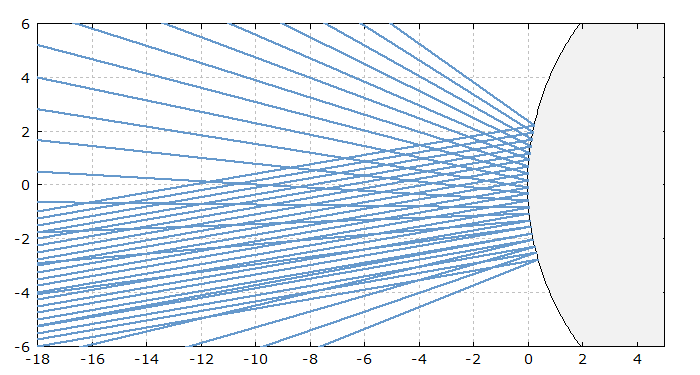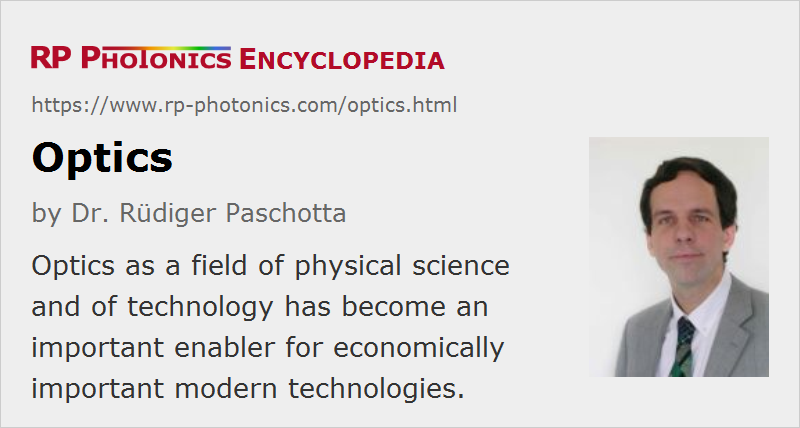Optics
Definition: the science and technology dealing with the properties and the propagation of light
German: Optik
How to cite the article; suggest additional literature
Author: Dr. Rüdiger Paschotta
Optics has been started many centuries ago as the science dealing with the properties of light – a part of the discipline of physics. It also became more and more important for practical applications and can therefore now also be regarded as an important field of technology. As the properties of light have already been known quite precisely for several decades, most of current optics research focuses on applications. For example, one can study technical optics, which focuses on the operation principles and further optimization of various optical components and devices.
Optics plays a crucial role in the area of photonics, mainly concerning various properties of light and on its propagation e.g. through transparent optical materials. It also has a very substantial economical importance as an enabler for many other modern technologies. However, many details of the generation and detection of light lie outside the field of optics, which deals mainly with the propagation of light. Photonics contains other important fields like laser physics which interface with optical physics.
Nowadays, optics deals not only with visible light, but also with infrared and ultraviolet light, as these have many properties in common with visible light, and are often utilized with similar optical components.
Classical Optics
Geometrical Optics
To some extent, the propagation of light can be described with ray optics or geometrical optics, where light is considered to consist of rays which propagate along straight lines, at least in homogeneous optical media. The effects of optical components on light rays is often described with an ABCD matrix algorithm.

Although geometrical optics has serious limitations – it cannot describe various important physical phenomena involving diffraction or interference, for example – it is still useful. For example, many properties of optical imaging systems containing mirrors, lenses, prisms etc. can be well understood with geometrical optics, although their performance limitations can not be completely explained with ray optics.
Physical Optics, Wave Optics

Some physical phenomena show quite clearly that light has properties of waves, although the rather short wavelengths of light do not always make that obvious. However, interference and diffraction processes in particular are hard to explain without optical waves. Around 1865, James Clerk Maxwell managed to demonstrate that light can indeed be identified with transverse electromagnetic waves of frequencies of the order of hundreds of terahertz. This quickly explained many phenomena e.g. in the context of diffraction and polarization. Some of the first practical results were explanations for the limited optical performance e.g. of microscopes and telescopes, and hints towards further optimization of their performance.
Light propagation in optical fibers can also be well described only with ray optics; see Figure 2 for an example.
Beyond an improved understanding, many new kinds of devices and operation principles have resulted from the evolution of physical optics and wave optics. For example, powerful spectrometers based on diffraction gratings have been realized, dielectric coatings (thin-film coatings) have become very important in various fields of photonics, and optical resonators play important roles e.g. as optical filters and as laser resonators.
Large parts of physical optics require quite sophisticated and partly abstract mathematical methods, although greatly simplified mathematical methods are still sufficient for many purposes. Numerical computation methods have become very important, greatly simplifying the work in many cases.
Quantum Optics
Although the description of light as classical electromagnetic waves, as developed in the 19th century, has been extremely successful, it became apparent in the early 20th century that there are phenomena which are hard to explain on that basis. For example, Albert Einstein realized that the photoelectric effect seemed to suggest that light energy is not delivered continuously, but in certain discrete packages, which are nowadays called photons. The further development of quantum mechanics led to a physical description which reconciles quite well the wave nature and apparent particle properties of light, although the resulting physical model is hard to bring together with intuitive ideas, and some aspects of quantum physics are still a matter of debate, essentially concerning interpretations. Note, however, that there seem to be no logical flaws or gaps of understanding in the sense that phenomena could not be properly described or predicted.
The field of optics which is specifically dealing with quantum effects is called quantum optics. In recent years, quantum optics has led to interesting technological developments; important keywords are quantum cryptography (for secure data transmission based on physical principles) and quantum computing.
Technical Optics
Technical optics is based on optical physics, but focuses on optical components and systems for transforming and utilizing light, not on studying the properties of light itself. Some examples for areas of activity and technical optics are:
- Modeling and design methods for developing optical systems are still being further refined and optimized. While in the early times sophisticated mathematical methods were defined, numerical computational methods have become more and more important. Partly, they are based on previously developed mathematical methods, and partly they replace analytical methods with numerical approaches, which are sometimes substantially more practical.
- Optical materials and their fabrication are further optimized, and occasionally new materials are developed.
- Various optical components and devices are also developed further, and new concepts are introduced. Some progress in optical technology is based on new materials or improve fabrication technologies, which can be utilized e.g. for improving the performance of optical systems or making them simpler, more compact and less expensive. For example, new fabrication techniques for aspheric optics and high-quality plastic optics allow one to realize extremely compact photo cameras with astonishing performance figures.
Much of technical optics is based on classical optics, i.e., not involving quantum effects.
Modern optics deals with light propagation not only in “simple” artificial media, but also for example in the atmosphere (atmospheric optics) and in strongly scattering biological materials.
Questions and Comments from Users
Here you can submit questions and comments. As far as they get accepted by the author, they will appear above this paragraph together with the author’s answer. The author will decide on acceptance based on certain criteria. Essentially, the issue must be of sufficiently broad interest.
Please do not enter personal data here; we would otherwise delete it soon. (See also our privacy declaration.) If you wish to receive personal feedback or consultancy from the author, please contact him e.g. via e-mail.
By submitting the information, you give your consent to the potential publication of your inputs on our website according to our rules. (If you later retract your consent, we will delete those inputs.) As your inputs are first reviewed by the author, they may be published with some delay.
See also: light, geometrical optics, wave optics, photonics, laser physics, quantum optics, diffraction, interference, microscopes, cleaning of optics
and other articles in the category general optics
 |




If you like this page, please share the link with your friends and colleagues, e.g. via social media:
These sharing buttons are implemented in a privacy-friendly way!